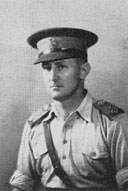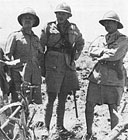
4
Teething Troubles overcome
On 13 August 1940, 1st South African Division under command of Brigadier-General George Brink and consisting of 1st S.A. Infantry Brigade Group already in Kenya, and 2nd and 5th S.A. Infantry Brigade Groups, was officially formed, initially with Lieutenant-Colonel W. H. E. Poole as G.S.O.1.
On a tour of duty overseas during 1937, General Brink had studied the latest developments in Britain, Germany, France and Italy, and in the capacity of Deputy Chief of the General Staff and Director of Army Organization and Training from May 1939, he had directed the training of South Africa's field army till his appointment as South Africa's first divisional commander. With Lieutenant-Colonel Poole being appointed Commandant of the Military College, his place as G.S.O.1 was taken by Colonel S. J. Joubert, a British Staff College graduate, who had served a brief attachment to the German Army, in January 1939, followed by a spell in Italy. As Senior Staff Officer on the staff of General Sir Pierre van Ryneveld shortly after the outbreak of war, Colonel Joubert had been largely responsible for the detailed staff work on which the wartime build-up of the South African forces had been based.
Proposals for distinctive flashes for South African troops were submitted to General Brink, who recommended their adoption and they were approved by Defence Headquarters, thus becoming the flashes of 1st, 2nd and 3rd S.A. Divisions, followed later by the green and gold superimposed triangles of 6th S.A. Armoured Division.*
While General Brink's Headquarters was still forming, 1st S.A. Infantry Brigade Group at Gilgil was having inevitable teething troubles. A number of changes in officers' postings was effected towards the end of August.
Lieutenant-Colonel L. N. Hay, M.C., V.D., after a period of
* The Union Defence Force had now adopted as uniform for bush warfare the khaki bush-shirt, with khaki drill slacks, anklets and boots. Full webbing was worn in the field and regulation headgear was the light, polo-type helmet. The first morning Colonel Joubert walked into the headquarters of 1st S.A. Division, the Adjutant-General's staff appeared with scrolls of expensive drawing-paper on which there were designs for flashes for every unit of the newly constituted division. On a sheet of paper Colonel Joubert drew a square, a circle and a rectangle. He drew a diameter through the circle, bisected each of the other designs with one straight line and wrote 'Gold' in the upper and 'Green' in the lower segment of each of them. Selecting the square as the flash of 1st S.A. Division, it then dawned on him that by balancing this design on one corner it became a diamond, and this was adopted.




